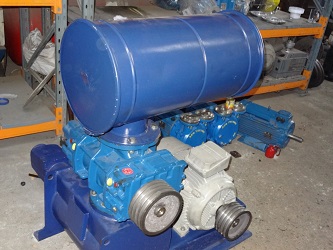How Liquid Ring Vacuum Pumps Work
Liquid ring vacuum pumps are rotating positive displacement machines providing process vacuum in industrial applications such as chemical, electrical power, environmental, food & beverage processing and packaging, marine, mining, oil & gas, pharmaceutical, pulp & paper, and textiles. Liquid ring vacuum pumps utilize water or other processes compatible liquid as the sealant. The simple operation, with no contacting parts, make liquid ring vacuum pumps a safe and reliable choice for handling dirty and potentially dangerous gas streams. Liquid ring pumps are available in single and dual stage designs and also configured as compressors for even more versatility.
Principle Of Operation
The seal liquid forms the ring inside a pump body as the impeller spins creating small chambers for gas to be trapped. The axis of the rotor is eccentric from the body allowing the liquid to almost fill, and then almost empty each rotor chamber during a single revolution, forming the compression of the gas for the pumping action. Vacuum inlet and atmospheric discharge ports provide flow paths for the gas mixture being handled. The heat of compression of the gas is dissipated into the seal liquid, and some of the liquid flows out to discharge. The exhaust gas and residual water discharge is separated from the gas stream and directed to the house exhaust and returned to the pump respectively. Seal fluid is replaced by a constant flow of cooler seal fluid.
Watch This Video To Learn “How It Works”
Characteristics Of Liquid Ring Vacuum Pumps
Accepts Carryover – Soft solids, moisture, slugs, chemicals and more will not harm the pump. These impurities will simply be washed out through the pump discharge.
Cool & Quiet Operation – The pump runs cool owing to the circulation of the sealing water inside the pump. The operation is relatively quiet – not exceeding 85 dBA.
Constant Operation For Any Vacuum Level – Pump can operate constantly and continuously at any vacuum level – from 29 in. Hg to atmospheric pressure.
Liquid Ring Technology How it Works
Easy Maintenance & Longer Pump Life – Liquid ring vacuum pumps are robust in construction and have only one moving part, the rotor, which is mounted on a shaft supported by a set of bearings designed for a long service life of continuous operation. This benefits the user with less wear and simpler, affordable maintenance.
Environmental – Pumps do not require an oil change, filter, oil-pans, condenser or etc. For that reason, plant rooms run clean, free of oil contamination and oil discharges to sewers.
A Look Inside A Liquid Ring Vacuum Pump
Flat Sided Liquid Ring Vacuum Pump
Conical Liquid Ring Vacuum Pump
The Technology Behind Liquid Ring Vacuum Pumps
The design technology behind liquid ring vacuum pumps is advanced to achieve optimum, reliable performance for the rigorous demands of harsh industrial environments. Liquid ring vacuum pumps are an economical and robust solution engineered to meet specific customer requirements.
Condensation Of Vapors Can Yield A Capacity Bonus
Dry air or a dry gas mixture is compressed from vacuum to atmospheric pressure in a liquid ring pump much the same way as it would be in any other displacement type pump, except that there is less of a temperature rise of the gas stream through the pump.
Humid air or gas mixtures containing condensable vapor behave quite differently. Some of the vapor that enters a liquid ring pump condenses when it is cooled by the lower temperature seal liquid. The condensate mixes with the seal liquid. Now, it occupies a much-reduced space as contrasted with its former volumetric dimension when it was a component of the inlet gas stream. This volumetric reduction becomes a capacity bonus.
The only vapor that can be condensed early enough to escape compression contributes to the inlet capacity bonus. In each rotor chamber, the condensation must occur before that chamber passes its inlet port. Any condensation that occurs after the cutoff will not have an effect on pump inlet capacity.
Liquid ring vacuum pumps can handle large amounts of liquid through its inlet port with a negligible reduction of gas capacity. To maximize the condensation bonus some of the liquid is often sprayed into the inlet piping, upstream of the vacuum pump itself.
Global Provider
Backed by over 110 years of experience, NASH CERTIFIED experts provide aftermarket support with maintenance, service, parts, and repair. Service centers are globally located to protect your vacuum system investment and provide quality, reliable, and efficient solutions.
Relat

دیدگاهتان را بنویسید